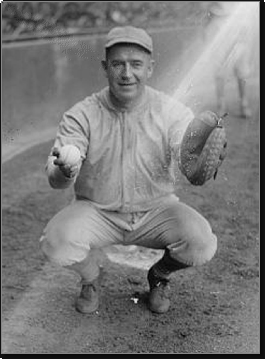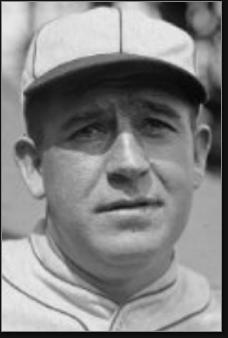
Frank Bruggy
Sports: Basketball & Baseball
Born: May 4, 1891
Died: April 5, 1959
Town: Elizabeth
Francis Leo Bruggy was born May 4, 1891 in Elizabeth. Frank was a big, rugged boy who wasn’t particularly quick, but was smart and coordinated. He excelled in baseball, football and basketball at the parks and gyms of Elizabeth and became a star athlete in high school and college, at Seton Hall University. Starting as a teenager in 1908, he began picking up extra income playing basketball for semipro teams in Elizabeth. In the years that followed he played for independent clubs in Brooklyn, Hoboken and Union Hill, and continued playing while in college.
After graduating in 1912, Frank signed a minor-league contract with the Providence Grays of the International League. He backed up catcher Gabby Street, who had played several seasons in the majors and would become a successful manager in the 1920s and 30s. Frank played in the minors for several more years and was a consistent .300 hitter.
During baseball’s off-seasons, Frank continued to play basketball professionally. He suited up for a number of teams in leagues in New Jersey, Connecticut, Pennsylvania and New York—sometimes playing for several clubs at the same time for a few dollars a game plus expenses. At 5’11 and 190 pounds, he was one of the beefier players in the pros, and he was not afraid to rough up opponents and intimidate referees. Off the court, however, he was known for his jovial nature and big personality.
In the ’teens, Frank became a star in the New York State League and Connecticut State League. He led the CSL in scoring in 1917–18 with 175 points in 18 games. In 1919–20, Frank coached and was the leading scorer for the Scranton Miners of the Pennsylvania State League. The Miners featured a 21-year-old giant named Stretch Meehan and future Hall of Famers Nat Holman and Elmer Ripley. They played Nanticoke in the PSL finals and lost 3 games to 1. The following season, he put together a barnstorming outfit called the Frank Bruggy All-Stars, while also playing 43 games for teams in three different leagues, including Scranton—which returned to the finals and won in 1921. In 1922-23, Frank was player-coach for Elizabeth of the Metropolitan League. That was his final season as a full-time basketball player. Frank was in the majors by this time and wanted to focus on that part of his career. 
Frank made the Phillies out of spring training in 1921 and hit .310 as their everyday catcher. The highlight of his rookie season was catching for the National League in an All-Star Game to honor the memory of Ray Chapman, the Cleveland Indians shortstop who had been killed by a pitched ball the season before. Frank singled and doubled and drove in three runs.
After a game in Philly later that season, Frank was driving a car with several teammates when two pedestrians darted in front of him. Fortunately, he did not run them over. Unfortunately, the players began cursing at them and a fight ensued. Infielder Jimmy Smith (who would later become a noted bootlegger) got into a fight and all of the Phillies were arrested. Frank was released without charges being pressed.
Following the 1921 season, the Phillies sold Frank to Portland, but he was acquired by the Philadelphia Athletics before reporting to the club that spring. From 1922 to 1924, Frank was the backup catcher for the A’s, behind Cy Perkins. The two backstops became fast friends and occasionally golfed with manager Connie Mack. Mack often used Frank to catch Eddie Rommel’s knuckleball. In 1922, Frank recommended a friend, Otto Rettig, to Mack as an emergency pitcher. Frank had caught Rettig at Seton Hall. Rettig surprised everyone by beating the Browns 6–3 and hurling a complete game. Frank was unable to coax another victory out of his old teammate and Rettig’s big-league career was over after three more appearances.
The arrival of Mickey Cochrane in 1925 made Frank expendable and he caught on with the Reds for a month before hanging up his spikes. He retired with a career .277 average. Frank actually tried a comeback in 1927, but did not make an official appearance. The Chicago white Sox suffered a string of injuries to their receiving corps that summer and were desperate for help. Frank seemed like a good choice, given his experience handling the knuckleball (Sox ace Ted Lyons threw the pitch). However, when he showed up he was so fat and out of shape that the Chicago pitchers refused to take the mound if player-manager Ray Schalk—a catcher himself—dared to put Frank behind the plate. A 25-year-old Newark native who'd never played an inning behind the plate became Chicago’s everyday catcher instead. His name was Moe Berg.
Post-career, Frank stayed in close contact with his baseball pals and participated in several old-timers events in Philadelphia. He also reunited with his basketball-playing peers, who formed a group called the Oldtime Basketball Players. As a two-sport star he was often featured in newspaper write-ups about their reunion dinners, being mentioned prominently well into the 1950s.
During the 1930s and 1940s, Frank worked as a detective for the Union County Prosecutor’s Office. He passed away in his hometown at the age of 67 and was buried in Colonia.
|